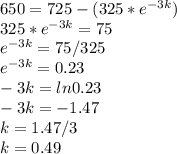
Mathematics, 28.05.2020 20:09, dropnsocks8315
The rate of change of the number of mountain lions N(t) in a population is directly proportional to 725 - N(t), where t is the time in years. When t = 0, the population is 400. When t = 3, the population is 650. Find the population when t = 5. Round your answer to the nearest 50 mountain lions. a. Write the implied differential equation. b. Solve the equation to find the general solution. c. Use the given information to find a particular solution. d. Use the particular solution to answer the question.

Answers: 3
Other questions on the subject: Mathematics

Mathematics, 21.06.2019 20:30, elijah4723
1) you deposit $2,500 in an account that earns 4% simple interest. how much do you earn in eight years?
Answers: 1

Mathematics, 21.06.2019 20:40, guyfromnasa
Which questions would most a reader identify the author's purpose for writing? check all that apply. what type of text is this? what type of reviews did the book receive? how many copies of the book have been sold? what is the central idea? how does this text make one feel?
Answers: 2

Mathematics, 21.06.2019 23:00, alyonaprotopopova
What ia the sum if the first 7 terms of the geometric series
Answers: 2

Mathematics, 22.06.2019 02:30, jdbessix3567
If wxyz is a square, which statements must be true? plz < 3
Answers: 1
Do you know the correct answer?
The rate of change of the number of mountain lions N(t) in a population is directly proportional to...
Questions in other subjects:

Mathematics, 25.08.2021 04:50


English, 25.08.2021 04:50

Geography, 25.08.2021 04:50

Mathematics, 25.08.2021 04:50

Mathematics, 25.08.2021 04:50

Spanish, 25.08.2021 04:50

Chemistry, 25.08.2021 04:50

Mathematics, 25.08.2021 04:50
















